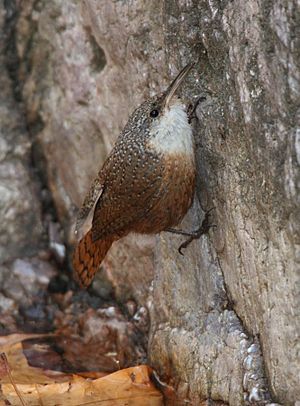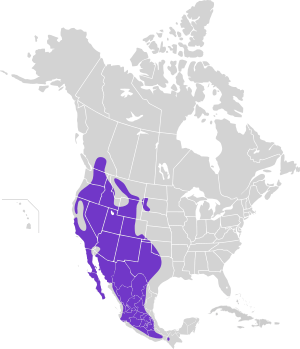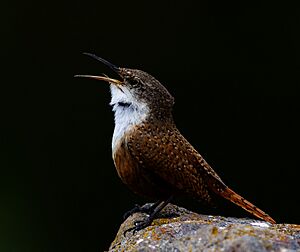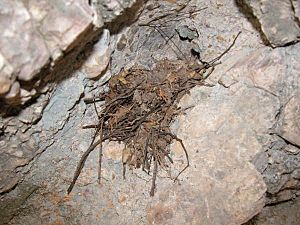Canyon wren facts for kids
Quick facts for kids Canyon wren |
|
|---|---|
 |
|
| in Madera Canyon, Arizona | |
| Conservation status | |
| Scientific classification | |
| Genus: |
Catherpes
|
| Species: |
mexicanus
|
 |
|
The canyon wren (Catherpes mexicanus) is a small North American songbird. It belongs to the wren family called Troglodytidae. These birds do not migrate. They live across western North America. You can find them in dry, rocky places. This includes cliffs, rock formations, and canyons. It is a small bird. Its rocky home makes it hard to spot. People often find it by its loud, special song. Currently, this species is the only one in its genus, Catherpes.
Contents
Discovering the Canyon Wren
What's in a Name?
The canyon wren's genus name is Catherpes. This name comes from a Greek word. "Kathero" means "to creep down." This describes how the bird clings to vertical walls. Its species name, mexicanus, tells us where it is often found. It refers to the country of Mexico.
Scientists have studied and debated this bird's classification for many years. It was first placed in the genus Thryothorus. Later, it moved to the genus Salpinctes with the rock wren. Some researchers still group it there. However, as of 2025, the canyon wren is the only species in its own genus, Catherpes.
Scientists recognize 8 different types, or subspecies, of Catherpes mexicanus:
- C. mexicanus cantator
- C. mexicanus conspersus
- C. mexicanus croizati
- C. mexicanus griseus
- C. mexicanus meliphonus
- C. mexicanus mexicanus
- C. mexicanus pallidior
- C. mexicanus punctulatus
How to Spot a Canyon Wren
The canyon wren is about 5 1/2 to 6 inches long (14-15 cm). It has a long, thin beak. Its tail is square-tipped. Its body is speckled and chestnut-colored. This color fades to gray on its head. It has a bright white patch on its throat. Its colors and small size help it blend in perfectly. It can hide very well in its rocky home.
Its Unique Song
The canyon wren has a loud, special call. It sounds like a series of notes falling down. It sings most often in the spring. However, mated pairs might sing at any time of year. When it protects its home, its song changes. It becomes harsher and has a lower sound.
Where Do Canyon Wrens Live?
Canyon wrens do not migrate far. But individual birds might move short distances with the seasons. Their usual home stretches from southern British Columbia. This includes the Okanagan Valley. It covers much of the western United States and Mexico. Some groups live in separate areas. These include the Black Hills of southwest South Dakota. They are also found in northeast Wyoming and southeast Montana.
Home Sweet Home: Canyon Wren Habitats
Like the rock wren, the canyon wren loves steep, rocky places. They especially like dry areas. But they can also be found near rivers. Canyon wrens live all year in large territories. These areas are spread out. They use them for finding food, breeding, and nesting.
In Colorado, canyon wrens often live near cliff swallows. Cliff swallow nests offer places for wrens to find food. Sometimes, canyon wrens even use these nests as their own.
What Do Canyon Wrens Eat?
The canyon wren has a long, slender beak. It uses this beak to search cracks in rocks. It looks for small insects and spiders. Sometimes, it will even take prey from spiderwebs or wasp nests. It mostly hunts on rock surfaces. But it might also hunt in bushes. It can even catch insects in the air.
Canyon Wren Reproduction and Nests
Canyon wrens choose safe places for their nests. They usually pick rocky cracks. Less often, their nests are in hollow tree stumps. They can also be found in human-made structures. Sometimes, they even nest in living trees. Both male and female wrens help build the nest. They start with a base of rough materials. This includes twigs, grass, and bark. On top of this, they build a smaller, cup-shaped nest. This part is made of soft materials. These include fur, spiderwebs, feathers, and plant down. Canyon wrens sometimes use the same nests again in later years.
The pair will lay 4 to 6 small white eggs. They do this 1 or 2 times each year.
See also
 In Spanish: Cucarachero barranquero para niños
In Spanish: Cucarachero barranquero para niños




